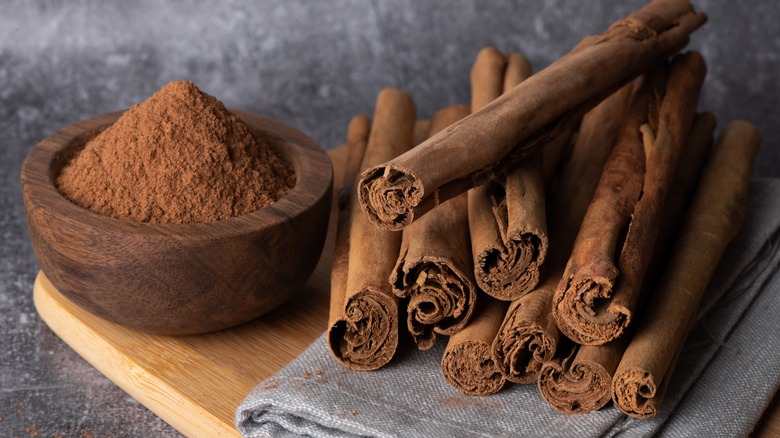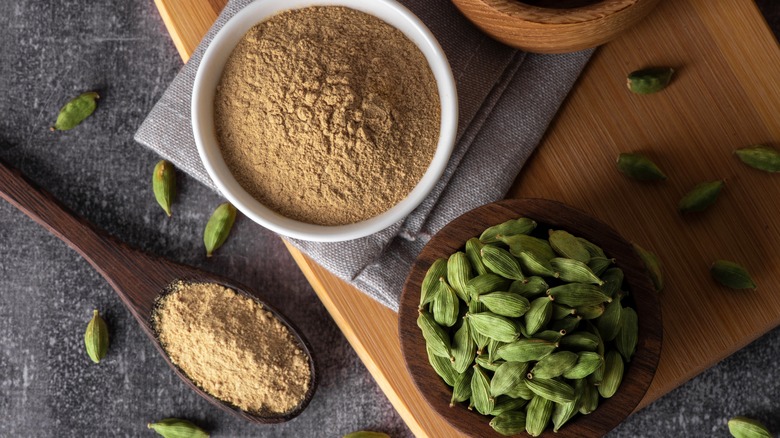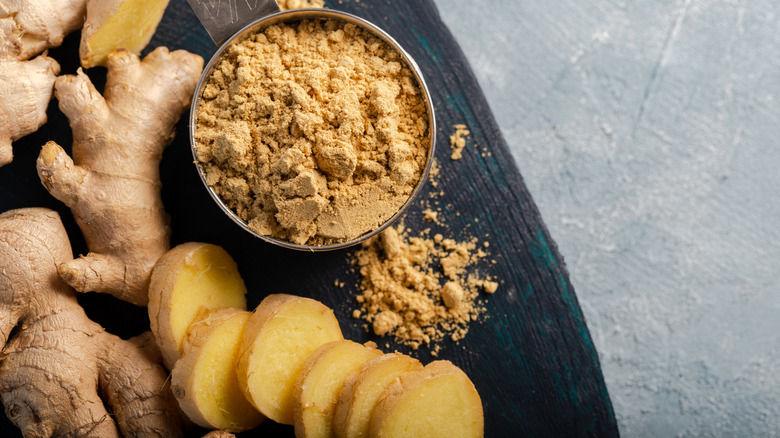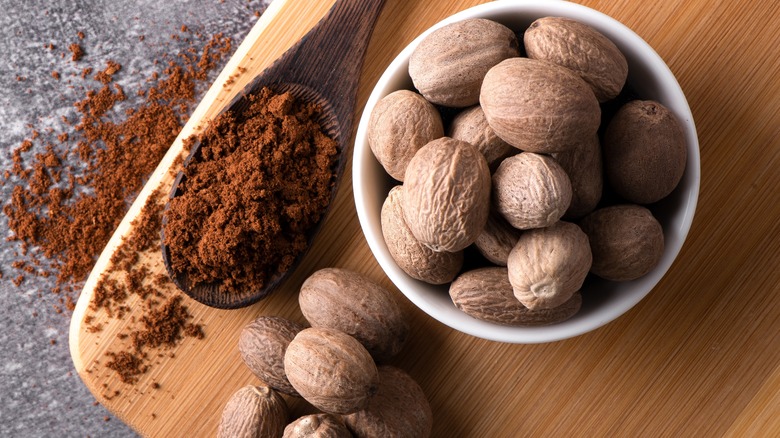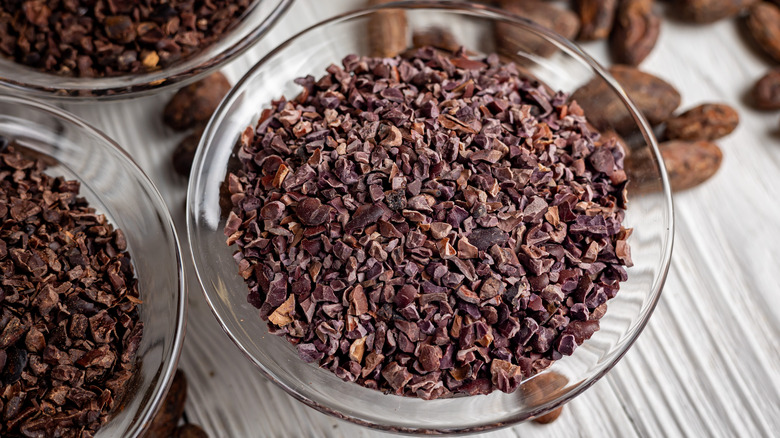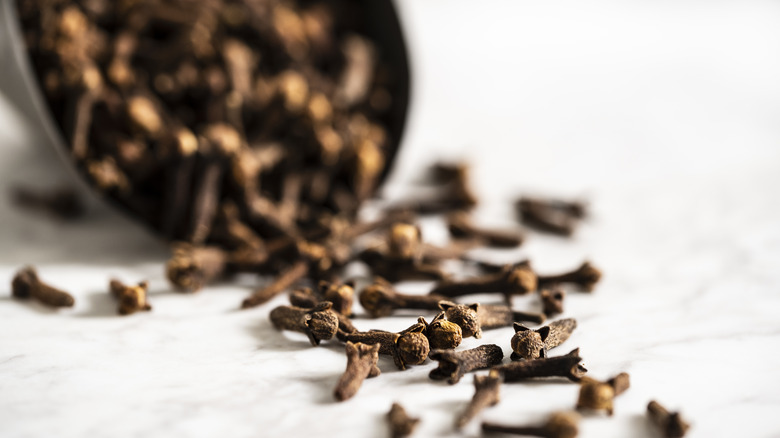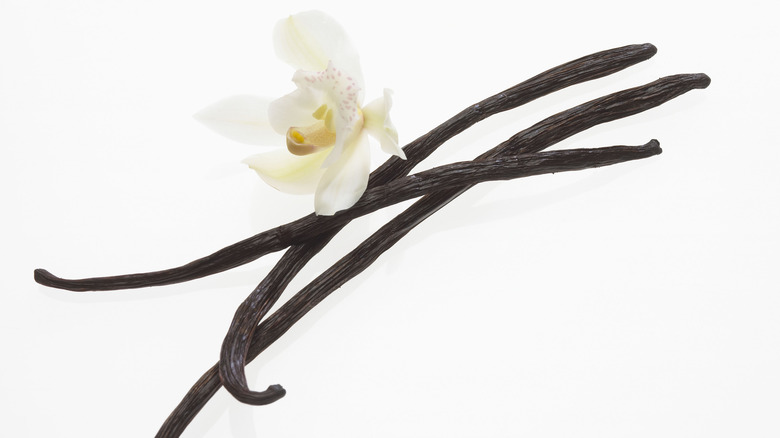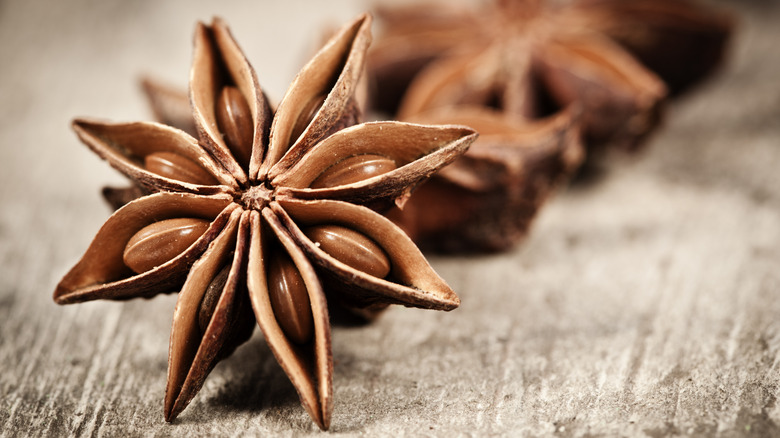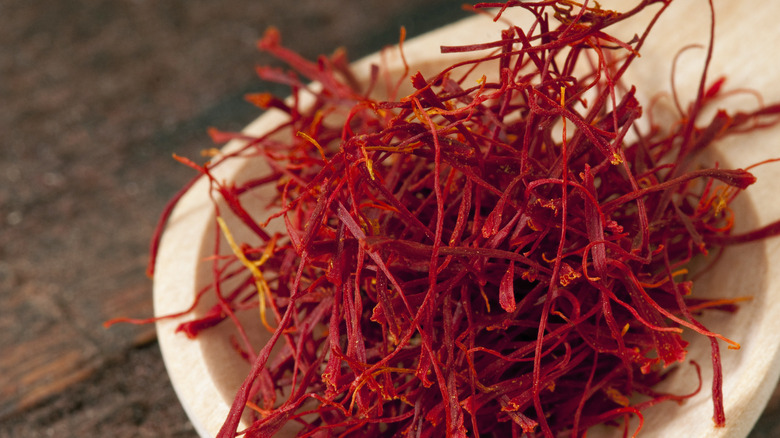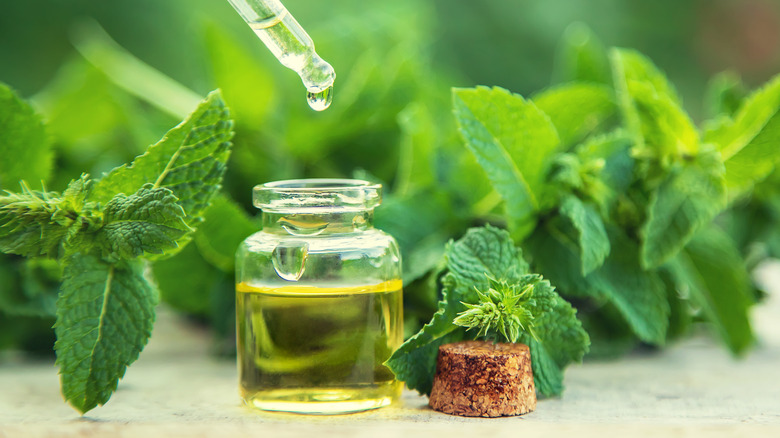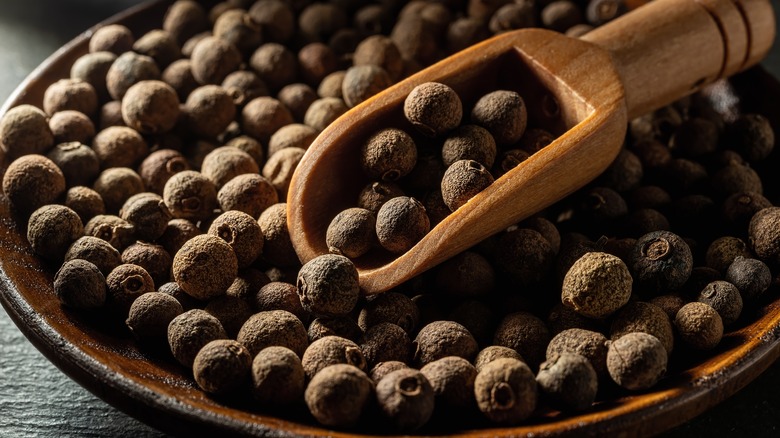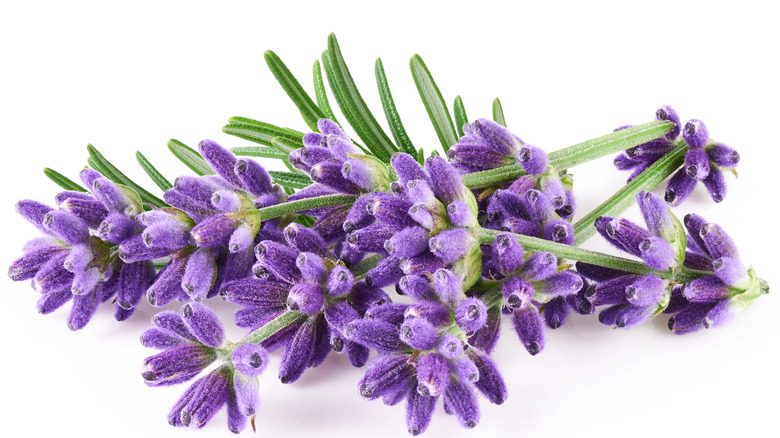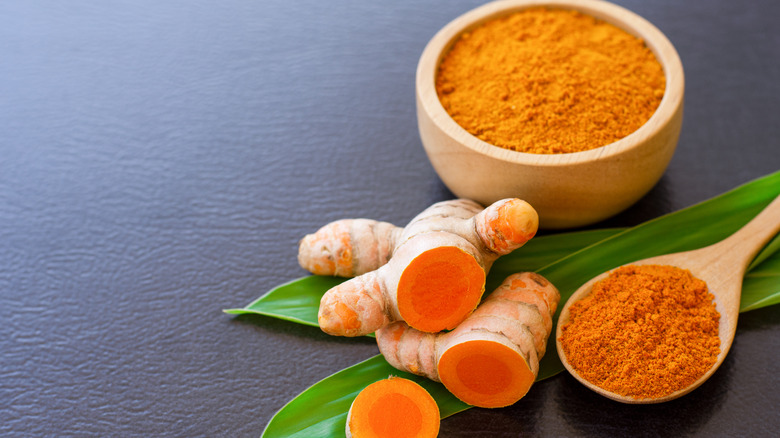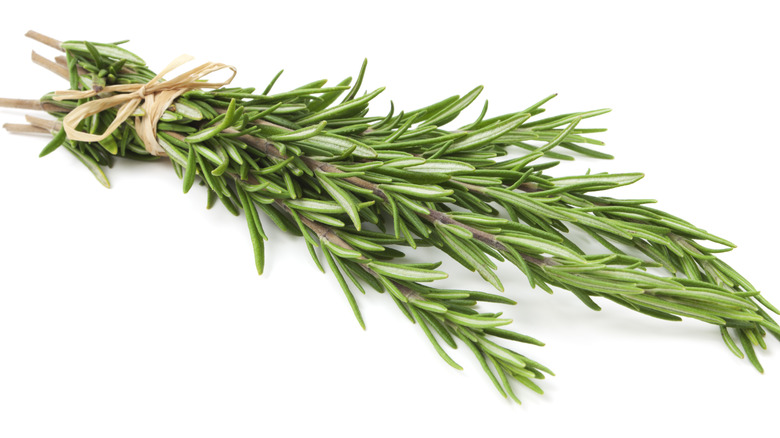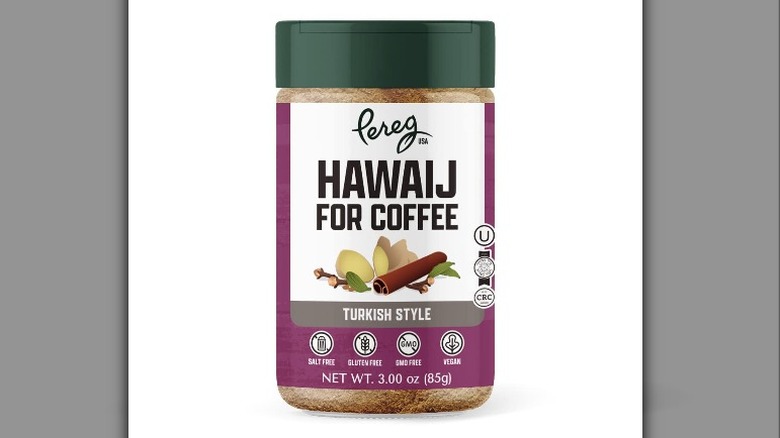16 Spices To Elevate Your Regular Cup Of Coffee
There are few pleasures greater than grinding coffee beans, pouring boiling water into your French press or Chemex, and waiting for the dark brown liquid to appear as you inhale the aroma of the day's first cup of coffee. But what should you do if you're looking to upgrade your daily coffee ritual? The solution doesn't involve purchasing new beans or investing in a fancy coffee machine. All you've got to do is get creative with the spices you probably already have laying around the kitchen.
That's right: A sprinkle of cinnamon here or a dash of nutmeg there can transform your daily cup into a coffeehouse-level masterpiece. In this article, we describe different spices you can add to elevate your regular cup of coffee. Besides giving you the full flavor rundown for each spice, we've also got pairing advice and share some potential health benefits. So if you're ready to put a new spin on your coffee, be sure to keep reading.
1. Cinnamon and coffee are a match made in heaven
You don't have to be a barista to know that cinnamon and coffee go well together. In fact, there's a good chance you've been sprinkling cinnamon onto your cappuccino without even thinking about it. Adding a dusting of cinnamon as a finishing touch is fine, but unless you're combining cinnamon with freshly ground coffee beans, you're missing out on the sweetness and warmth of this aromatic spice.
To make the perfect cinnamon coffee, we recommend starting with medium or dark-roast coffee beans. In many cases, roasting also brings out notes of nuts, caramel, and chocolate, all three of which pair beautifully with cinnamon. Add ground coffee and ground cinnamon to your coffee maker or pour over. Wait for the coffee to brew, then enjoy the sweet, woody flavor notes. Half a teaspoon of cinnamon is enough to flavor six cups of coffee but feel free to add more if you prefer a stronger flavor.
2. Cardamom gives coffee a Middle Eastern flavor
If you're like us, you probably have a jar of cardamom sitting in the back of your cupboard gathering dust. Sure, you might pull it out every once in a while to make cardamom blueberry muffins, but chances are you don't give this traditional Indian spice more than a passing glance.
That's a shame because this peppery, citrusy, slightly floral spice pairs perfectly with coffee. It's a common ingredient in Arabic and Turkish coffee thanks to the delicate spiciness it adds. From pods to essential oil, cardamom comes in many foams. When adding it to coffee, we recommend using green pods or powder. If using pods, mix a few into your grinder along with your regular coffee beans. From there, brew the coffee as you normally would. Pressed for time? Crush a few pods and add them directly to your brewed coffee.
3. Adding ginger turns regular coffee into a holiday treat
With its spiciness and warmth, ginger conjures up all kinds of holiday memories like decorating gingerbread houses and dunking ginger cake into a steaming cup of hot chocolate. Capture some of this holiday magic but incorporating ginger into your regular cup of coffee.
Depending on what you have on hand, you can incorporate either fresh or powdered ginger into your coffee. When using fresh ginger, place a few slices on top of your coffee ground before brewing. If using powdered ginger, incorporate one teaspoon for every six tablespoons of coffee. Not only does ginger elevate your regular cup of coffee, but it also provides all kinds of health benefits. According to Healthline, ginger can help soothe nausea, indigestion, and menstrual cramps. It also helps keep blood sugar levels balanced, something that will give you an extra burst of energy without the need for more caffeine.
4. Nutmeg enhances coffee's nutty notes
With its warm, slightly spicy flavor, nutmeg turns your regular cup of coffee into a fragrant autumnal blend. Plus, TikTok barista Morgan Ekroth approves, so you know it's gotta be good. Although you'll definitely notice the difference in flavor, nutmeg's presence comes through most strongly on the nose, giving off a slightly sweet, nutty aroma.
Because nutmeg's flavor and aroma can be pretty strong, it's better to pair it with coffees that already have some spice to them. If you use a lighter blend, you risk overpowering the coffee. On a similar note, be careful about how much nutmeg you're adding. Just a dash per cup should be enough to perfume your coffee without ruining it.
In addition to its delicious taste and smell, nutmeg may provide health benefits. The spice contains antioxidants and anti-inflammatory compounds, both of which have been shown to control blood sugar and boost mood in animal studies (via Healthline).
5. Cocoa nibs transform regular coffee into a mocha
Cocoa nibs, also known as cacao nibs, are chocolate in its most basic form. The tiny shards are just dried cacao beans broken down into tiny pieces and packaged. Although they resemble chocolate, they lack the sugar, milk, and emulsifiers found in processed forms of chocolate. For that reason, they're bitter, crunchy, and not something you want to chow down on while watching rom-coms.
Although they lack sweetness, they've got a complex flavor profile that includes earth, nutty, and fruity notes. When combined with other ingredients, cocoa nibs give off strong hints of dark chocolate, making them the perfect coffee add-in for mocha lovers. To make a cup of this sweet treat, combine ¼ teaspoon of cocoa nibs with ⅓ of an ounce of coffee beans in your coffee grinder. Blend them together, then brew as you normally would. For the full mocha experience, top off your cup with some steamed milk and chocolate syrup.
6. Whole cloves are a throwback flavor
Maybe you've used cloves to make a fragrant pomander or to spice up mulled wine, but that's about it. While it's true that cooking with cloves can be tricky, they're worth experimenting with. Cloves are an essential ingredient in Café Touba, a popular caffeinated beverage in Senegal. They're also used to make Qahwa Ma'atra, a Moroccan beverage that combines cinnamon, ginger, and black pepper.
When combined with coffee, cloves give off woody and nutty notes that somehow feel nostalgic. These notes complement similar woody notes often found in Colombian beans. The best way to incorporate cloves into your coffee is by adding a few cloves to your beans, then grinding them together. After you've obtained the blend, use a French press, drip, or pour-over to brew the fragrant drink.
Healthwise, cloves contain high levels of beta-carotene. The body converts this plant pigment into vitamin A, something that promotes eye health. They also contain eugenol, an anti-inflammatory compound that may help prevent arthritis, per WebMD.
7. Give vanilla a second chance
Combining coffee and vanilla isn't cutting-edge. After all, Starbucks' menu is teeming with vanilla-based concoctions. From Vanilla Sweet Cream Nitro Cold Brews to Iced Blonde Vanilla Lattes, you'll have no trouble finding vanilla coffee out in the wild. But we're not referring to artificial syrups or infused beans. Rather, we're talking about combining vanilla beans or pure vanilla extract with coffee.
Compared to their artificial counterparts, vanilla beans and vanilla extract provide a sweet, creamy flavor to coffee, minus the extra calories and bizarre aftertaste. If using whole vanilla, a single bean is all you need. Simply grind it up along with the coffee beans, then brew together for the most fragrant cup of coffee your kitchen has ever seen. When using vanilla extract, add a couple of drops to your cup before sipping. In terms of health benefits, vanilla contains vanillin, a plant compound that's praised for its antioxidant, anti-inflammatory, and neuroprotective properties, per Healthline.
8. Star anise lends licorice notes to coffee
Like cilantro, white chocolate, and candy corn, licorice is one of those flavors that divides a lot of people. If you were one of those kids who traded boxes of Good & Plenty for pretty much any other candy, stay away from star anise. The licorice smell alone will be enough to make your lips curl up in disgust. However, if you love the sweet, woody, somewhat bitter flavor of licorice, then adding this Asian spice might be just what your cup of coffee needs.
Given how powerful the flavor is, we recommend using just half a pod per cup of coffee. Add any more and your morning treat will taste of nothing but licorice. Before brewing, you'll need to grind up the star anise using a mortar and pestle or a spice grinder. Mix the ground-up spice into the ground coffee and brew using your favorite method. Star anise is full of flavonoids, which, according to Healthline, have antioxidant, anti-inflammatory, and antimicrobial properties.
9. Adding saffron is a decadent way to upgrade your morning cup
Costing anywhere between $10 and $20 per gram, saffron is the most expensive spice in the world. In fact, the red threads from the crocus sativus plant are commonly referred to as red gold because of their high price tag. While the cost might be off-putting for some, you only need a pinch to elevate your regular cup of coffee.
The Middle Eastern spice is complex, to say the least. On the one hand, it has a sweet, earthy taste reminiscent of flowers and honey. On the other hand, it's slightly bitter. While you'll have a tough time sussing out all of the flavor notes, one thing is for sure — saffron and coffee are a dynamite combination. To prepare a simple saffron coffee, make a cup of espresso. Add steamed milk and a bit of honey. Next, crush a couple of saffron threads into the cup and stir. Finish by spooning some milk foam on top.
10. Peppermint makes coffee taste like Christmas
Along with gingerbread and eggnog, peppermint is a flavor that screams Christmas. For that reason, you're almost guaranteed to see peppermint mochas and lattes at your favorite coffee chains the minute the calendar changes from November to December. There's no denying how tasty they are, but at $6 or more per drink, they're not exactly wallet-friendly. Thankfully, there's a cheaper (and easier) way to get a delicious holiday drink.
Peppermint oil extract is all you need to put a festive spin on your daily cup of coffee. In no time, this hybrid blend of spearmint and watermint will turn any regular cup of coffee into a wintery treat. As the coffee brews, add a couple of drips to the pot. Just be sure to use sparingly. Fail to do so and the peppermint flavor will overtake all of the coffee notes. Finish off your drink with a splash of milk or even some whipped cream if you feel like indulging.
11. Allspice is for moments when you want all the flavors
With tasting notes similar to spices like cinnamon, clove, black pepper, and nutmeg, no one would fault you for being a bit confused about what allspice is. Although its flavor and name suggest that it's a blend, allspice is a species unto itself. The warm, earthy, and slightly bitter spice comes from dried, unripe berries of Pimenta dioica trees. Whole berries are used when cooking beef or lamb and it's a crucial ingredient when preparing the marinade for Jamaican jerk chicken.
In addition to its many savory uses, allspice is also an important ingredient for sweet recipes like spice cake, apple pie, and pumpkin muffins. Given allspice's versatility, it's only natural to combine it with coffee. For example, you could try making an allspice latte. To make this tasty treat, combine allspice, brown sugar, and water, then heat until a syrup forms. Combine the syrup with a piping hot espresso and you'll see what all of the fuss is about.
12. Cayenne pepper provides that extra jolt you need
Hey, we get it. Some mornings not even a double espresso is enough to wake you up. When the fatigue is real and you need something extra to shake off the drowsiness, consider adding some cayenne pepper to your coffee. We recommend combining it with coffee blends that feature notes of chocolate. This combo works well because the cayenne pepper helps bring out the nutty, citrusy, and fruit notes in chocolate blends, making them taste even better.
If you're feeling brave, there are two ways to spice up your coffee. The first is to combine a dash of ground cayenne pepper with coffee grounds, then brew the two together. Alternatively, you can stir a dash of ground cayenne pepper into an already-brewed cup of coffee or espresso. While there's nothing wrong with enjoying this combo black, adding some milk can cut down on the spiciness.
In addition to the complex flavors cayenne pepper helps highlight, the spice is also beneficial to health. According to Cleveland Clinic, cayenne pepper is high in vitamins A, B6, C, and K. The amount of vitamin A is especially notable. In just one teaspoon, you get 15% of your daily recommended dose. Besides aiding visual health, vitamin A plays a role in reproduction and immunity.
13. Spring comes early when you add lavender to coffee
There's a lot of talk about fall and winter coffee blends, but springtime flavors rarely get a mention. Why is that? We think it's high time to discuss the light flavors spring brings. With its sweet, floral, and slightly bitter notes, lavender is one of the season's most distinctive flavors and a top contender to replace your caramel macchiato or vanilla latte as the weather warms.
If you're feeling hesitant, we understand. Adding flowers to coffee does seem pretty strange. But consider this — plenty of coffee blends feature floral notes. By adding another floral flavor, you can enhance a flavor note that's often overlooked. Not only does lavender pair well with floral coffees, but it also complements bright, citrusy blends from Kenya and Ethiopia. One way to incorporate lavender into your coffee is by making syrup from fresh lavender, sugar, and water. Let the mixture simmer for 10 minutes, strain out the lavender, then cool to room temperature before adding it to a cup of coffee. If you want to go all out and make a lavender latte, mix in some honey, milk, and heavy cream.
14. Turmeric brings warmth and health
With its brilliant yellow color and fragrant ginger-like aroma, turmeric is a spice that's hard to miss. Turmeric is a standby in Indian curries but it's also been known to perk up otherwise bland foods like cauliflower rice and chicken. Thanks to its earthy, slightly bitter flavor profile, turmeric makes for an excellent addition to coffee. We recommend adding it to spicy or earthy blends like Sumatras. It's also a good idea to brew your coffee a bit stronger than you normally would so the turmeric doesn't overpower the rest of the drink.
The perfect cup starts with freshly brewed coffee. We recommend stirring ¼ teaspoon of ground turmeric into each cup of coffee. Additionally, you can also add ¼ of a teaspoon of cinnamon to help add some sweetness to the mixture. Besides cinnamon, cloves and ginger also pair well with turmeric coffee. While the flavor notes are what's most noticeable, turmeric is also a nutritional powerhouse. It contains curcumin, an antioxidant compound that lends anti-inflammatory and pain-relieving properties to the spice, per Healthline. That said, it's a good idea to add milk or creamer to the coffee to help your body better absorb the turmeric.
15. Fresh rosemary gives coffee a subtle earthiness
You're probably comfortable using rosemary to season soups, casseroles, and chicken dishes, but this spice is more versatile than you might think. Believe it or not, its delicate, earthy flavor gives coffee a delightful aroma and a subtle boost of flavor. In particular, it blends well with coffees that have earthy or spicy undertones, such as those found in Indonesian beans.
When making rosemary coffee, feel free to use a drip coffee maker, a pour over, or a moka pot. Place one sprig of fresh rosemary (or one tablespoon of dried rosemary) on top of the coffee grounds. Run your machine as normal, then discard the rosemary before serving. As you might have noticed, the perfect cup of rosemary coffee doesn't actually contain any rosemary. Rather, the final product should only contain rosemary oil, something that's released when you expose the spice to hot water. Another tip to get the maximum amount of flavor out of the rosemary is to rub the leaves with sugar before use. The sugar causes the leaves to release moisture, something that breaks down the cell walls and allows the aromatic compounds to come through even more intensely.
16. Kafe Hawaij is tailor-made for coffee
While the previous slides have focused on adding unconventional spices to coffee, there is one spice that's made specifically for coffee. Kafe Hawaij, a spice blend lovingly referred to as Middle Eastern pumpkin spice, is everything you love about fall coffee drinks minus the excess sugar and calories. The exact recipe is a secret, but we do know that it contains a blend of cardamom, ginger, cinnamon, and cloves.
Because it's made specifically for coffee, Kafe Hawaij is ridiculously easy to incorporate into your morning cup. All you have to do is stir the desired amount into one cup of coffee. Anywhere between ⅛ teaspoon and ½ teaspoon should be enough, but adjust according to your preferences. Alternatively, you can incorporate the powdered spice blend directly into your coffee grounds and brew as you normally would. Either way, it'll be love at first sip.
Static Media owns and operates Tasting Table and Mashed

